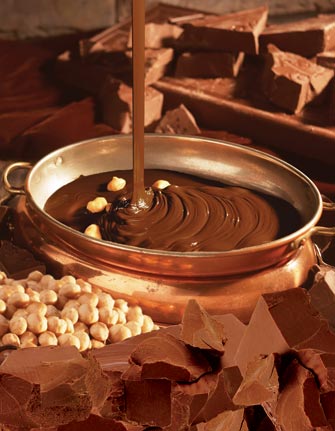FLAVORS
Title: The Darker the Better: Rowan Gard goes in search of the ultimate
chocolate indulgence
Words: Rowan Gard
Image: Image compliments of Hawaiian Host, the creator of the Original Chocolate-Covered Macadamia Nut, which uses only high-quality chocolate and premium macadamia nuts.

The noted sex therapist Dr. Ruth Westheimer described the taste of
chocolate as “a sensual pleasure in itself, existing in the same world
as sex…For myself, I can enjoy the wicked pleasures of chocolate
entirely by myself…furtiveness makes it better.” (Oh, Dr. Ruth, you’re
such a naughty girl!) It’s true that few (legal) edibles come close
to the glorious rapture that is sliding a piece of chocolate across
the taste buds. Why is it that chocolate consumption ranks up there
with the human nervous system’s equivalent of a three-cherry jackpot—
sex?! Well, recent research reveals that chocolate melting on your
tongue stimulates an increase in brain activity and heart rate which
surpasses that of levels associated with passionate kissing, not to
mention lasting four times longer after the fact. (Talk about
staying power!) So, simply put, chocolate literally makes you feel good. And with the
holiday season upon us, having a stash of chocolate on hand, either to
ease one’s own personal stress level or to give as gifts (you have to
admit, it’s vastly superior to tube socks, with the added allure of
being considerably cheaper than diamonds), will make for a much
merrier Christmas.
The Origins of Chocolate
Humans have furtively indulged in chocolate for a long while now. In
fact, recent archaeological research indicates that the ancient
Aztecs, Maya, and Olmec peoples made chocolate beverages as early as
1100 BC. There is also evidence of the cultivation of the cacao tree
—the seeds of which compose chocolate—in Mesoamerica for over three
millennia. (See, I told you it’s been a lengthy love affair.) The
scientific name for cacao, Theobroma cacoa, is literally Greek for
“food of the gods,” and the Aztec Emperor Montezuma (perhaps best known
for his long-standing gastric retribution) referred to liquid chocolate as a
“divine drink.” Mayan hieroglyphs even indicate that chocolate was
used for ceremonial purposes too, not just as a luxury good.
Following the Aztecs’ contact with the Spanish, chocolate came to
Europe in a big way. Chocolate consumption spread throughout the
royal courts of Europe and became much sought after. In 1657, the first
chocolate purveyor opened in London, but it wasn’t until the advent of
the Industrial Revolution that chocolate manufacturing and its
consequent consumption truly exploded. In 1850, cacao was introduced to
Hawai‘i, with interest in local-grown chocolate increasing through the
turn of the century. Following World War I, chocolate production
within the islands dropped, and it wasn’t until more recently, in
the 1990s and 2000s, that there has been a significant resurgence. And
my, my, what a resurgence it has been.
Home-Grown Indulgence
If you’re hungry for a near-orgasmic chocolate experience, then you
best make your way to one of these fine local chocolatiers that make
me proud to call Hawai‘i nei my home (trust me, not only do these
folks know what they’re doing, they’re so good you’re going to beg
them to never stop).
Kailua Candy Company
On a recent jaunt to the Big Island, I had the pleasure of visiting the
tasting room of Kailua Candy Co. (incognito, of course), which served
up great aloha and amazing chocolates. In fact, Kailua Candy Co. was
named one of the 10 Best Chocolate Shops in the United States by Bon Appétit
magazine, and I have to concur. Chocolate recommendations include the
hand-dipped tropical truffles, specifically the Lemon Macadamia Nut in
a white chocolate and the Guava-Rum in a dark chocolate, the latter
of which is so good you won’t even feel guilty when you slap your
tutu’s hand away and snatch up the last one!
Kailua Candy Company
73-5612 Kauhola Street, Kailua-Kona, Hawai‘i 96740
Kailua-candy.com 808.329. 2522 or 800.622.2462
Malie Kai Chocolates
Malie Kai chocolate, grown on O‘ahu’s North Shore, is one of the
rarest chocolates in the world. The Dark Chocolate Bar by Malie Kai
Chocolates is not to be missed. It has a rich “chocolate” flavor that
hits the front of your mouth and then follows up nicely with secondary
notes of black currant. (So damn good!) Make sure to stop by their
booth at the Kapiolani Community College Saturday morning Farmer’s
Market (located at 4303 Diamond Head Road, Honolulu).
(FYI: Recent medical studies indicate that dark chocolate, eaten in
moderation, can lower blood pressure and includes a substantial amount
of antioxidants. So now you can say with a straight face that you’re
eating that chocolate bar for “medical reasons.”)
Malie Kai Chocolates, Inc.
P.O. Box 1146 Honolulu, Hawai‘i 96807
www.maliekai.com 808.599.8600
Original Hawaiian Chocolate
The folks at Original Hawaiian Chocolate Factory are the first
producers to grow and process all-Hawaiian chocolate.
Chocolate recommendations for this pure Big Island goodness include
the dark chocolate Plumeria Nui Loa, which has a delicate yet complex
flavor that whispers of the volcanic soils in which it’s grown.
Original Hawaiian Chocolate Factory
78-6772 Makenawai Street, Kailua-Kona, Hawai‘i 96740
www.ohcf.us 808.322.2626 or 888.447.2626
“All I really need is love, but a little chocolate now and then
doesn’t hurt!” —Lucy, in Peanuts, by Charles M. Schulz. If you’d like
to show the author some love, then follow her blog—Respect the Food—
at www.strowanrespectsthefood.blogspot.com, or you can always just send
her a love letter at [email protected].
Recipe:
Easy-Peasy Ganache (courtesy of Kailua Candy Company)
Ingredients: Use equal parts dark Hawaiian chocolate and heavy whipping cream.
Preparation: First heat the cream in a microwave until hot
(approximately one minute on high heat), then melt the chocolate in a
double boiler (two different-sized pots work just fine too). Next,
slowly pour the cream into the melted chocolate and stir gently with a
whisk until silky smooth. This ganache is perfect over ice cream or
for dipping fresh fruit.

092a3735-2260-41da-a791-420803bb8935|2|5.0